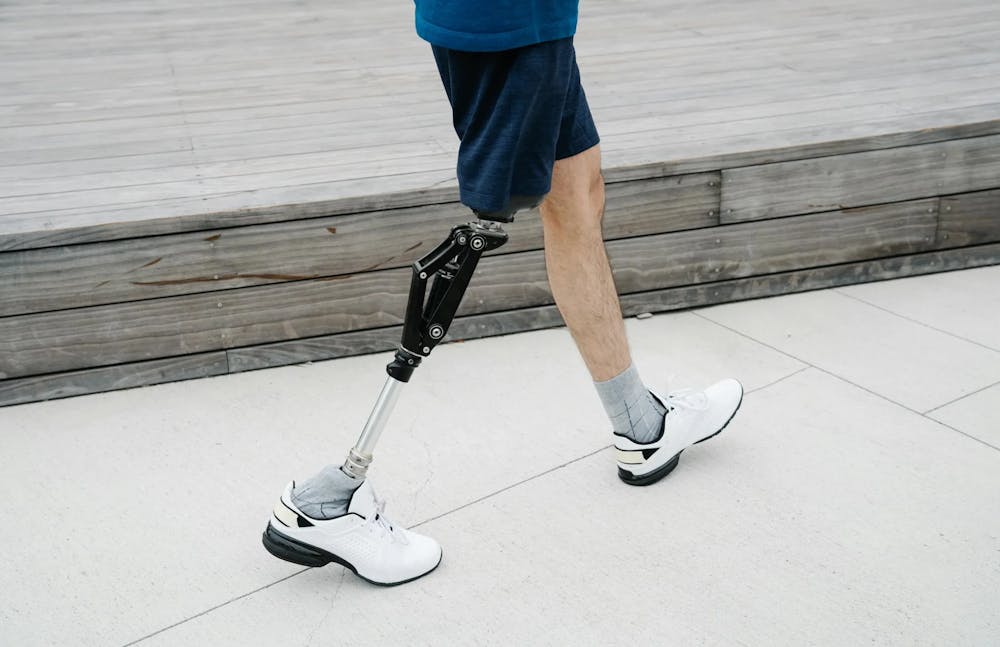On Thursday, Feb. 29, The Johns Hopkins Department of Mechanical Engineering hosted Michael Goldfarb, the H. Fort Flowers Professor of Mechanical Engineering and Director at the Center for Intelligent Mechatronics at Vanderbilt University. The talk shed light on novel perspectives regarding powered lower limb prostheses. Goldfarb discussed his research group's 15-year journey exploring the integration of power into lower limb prostheses in a lecture titled "A Powered-on-Passive Approach to the Design of Powered Lower Limb Prostheses." Assistant Professor of Mechanical Engineering Jeremy Brown organized the event.
Goldfarb began by discussing the history of lower limb prostheses, which replace the lower limbs to restore their functional or cosmetic purposes. The motion of these limbs and prostheses is divided into passive and powered behaviors. Passive behaviors of the knee have two stages: the stance phase, a position used during walking and descent down a slope, and the ballistic swing, which is the swing of the leg during a healthy walking motion.
Powered swing and powered stance refer to the powered behaviors of the knee, which are used in ascent up a slope, stumble recovery and slow-paced walking. Existing lower-limb prostheses focus on allowing users to perform passive behaviors. During the “stance” phase, resistance is at a high point, and this resistance to motion is lowered during the swing phase to allow the user to move their limb passively.
“Modern microprocessor-controlled knee prostheses [MPKs] are energetically passive, which means they cannot move by themselves… they function entirely by resisting movement,” Goldfarb explained during the talk.
He continued by discussing the inherent limitations of traditional prostheses, which, while offering support for passive limb behaviors, cannot adequately replicate the full range of motor behaviors of a healthy limb, particularly in stumble recovery. The advent of power prostheses was meant to fill the gap of such “powered” movements that traditional prostheses could not perform.
“People with prostheses fall a lot… One of the reasons is a lack of stumble recovery reflexes. We can put these in power prostheses to help people recover some [of this ability],” Goldfarb argued.
However, the advent of powered prostheses is paralleled by a tradeoff in the range of passive motions performed by powered prostheses. Providing a new range of behaviors in powered movement entails limiting the ability of the prosthesis to perform passive behaviors.
“When you have powered prostheses, you’re adding behaviors you didn’t have. The problem is you’re sacrificing or losing passive behaviors,” he said.
Goldfarb further delved into this tradeoff to explain its biological implications. He argued that, in some ways, the loss of passive movement negatively impacts user experience with the prosthesis, making it more difficult to use and lowering satisfaction with the overall product. As one example of this phenomenon, powered prostheses use power to replicate the passive motion of a ballistic swing, forcing a motion that is generally powered by the user’s passive force. However, this motion tends to be less controlled than traditional ballistic swing in passive prostheses and negatively impacts user satisfaction. Passive prostheses thus tend to be biomimetic, reminiscent of a biological leg.
To mitigate the loss of passive motion associated with powered prostheses, Goldfarb’s group worked on a two-speed transmission prosthesis that could switch between passive and powered movements. In low gear, the prosthesis allows powered and passive swing behaviors, and switching into high gear provides access to stance behaviors. The structure of the prosthesis further increases user agency by ensuring that passive behaviors are almost entirely user-generated.
Goldfarb then delved into the application of some of these concerns to multigrasp prostheses that enhanced upper limb functionality. Here, Goldfarb’s team used electromyography (EMG) signals, which record electrical signals obtained from neuromuscular activities, to help increase the control and precision of grasping behaviors in such prostheses.
“You want to reduce degrees of freedom, however, you also want to provide both precision grasp, but you also want to hold things in a controlled way,” he explained, alluding to the importance of user-centric design in prosthesis structure and biomedical engineering as a whole.
Goldfarb ended the lecture with takeaways on the future of prosthetic and orthotic device design. He emphasized the necessity of balancing the power with the preservation of passive functionality. This balanced approach not only promises to improve the functionality and acceptance of prosthetic devices but also to enrich the lives of individuals relying on these technologies for mobility and agency.





